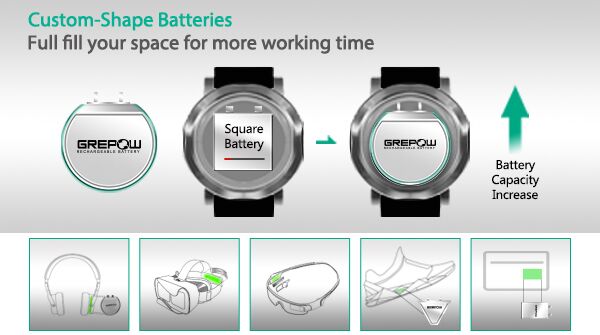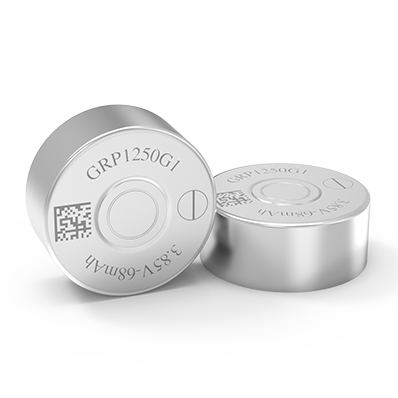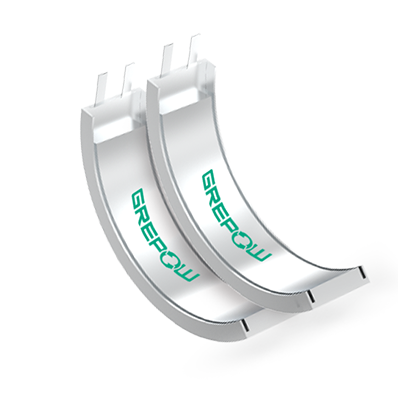Overcurrent Charging Protection for Wearable Devices Batteries
The overcurrent charging protection function in the protection circuit of wearable devices battery is due to the automatic jump of the step when the test equipment reaches constant voltage or the overvoltage protection of the battery protection circuit. Improper use can affect the performance of lithium polymer batteries, and even bring security risks. For example, overvoltage charging may cause the battery to explode, and a short circuit between positive and negative electrodes may cause a fire. For this reason, lithium polymer batteries are generally equipped with special protection circuits in their applications. The battery-specific protection chip (usually called protection °C) cuts off the circuit when it detects misuse of the battery, thus protecting the battery. The charging and discharging misuse of the battery includes charging or discharging to a normal voltage, using an excessive current for charging and discharging, and even short circuit directly between positive and negative electrodes. Lithium polymer battery protection circuits widely used in wearable devices, usually designed with battery charging overvoltage protection, low voltage discharge protection, short circuit protection, and overcurrent protection, but for a long time, overcurrent protection only considers overcurrent discharging, not include protection against overcurrent charging behavior.

In this view, Grepow Battery engineer analyzes the overcurrent charging protection function and discusses the possible misjudgment of the laboratory. The test method of the feasible overcurrent charging protection function is given below.
Wearable devices battery overcurrent charging protection
If lithium polymer battery charging current is too large, it will have a large impact on the electrode material structure, result from serious polarization of the battery, and may even cause thermal runaway. Charging with large rate will also affect battery life. In addition, larger current requires a higher current carrying capacity of the product circuit, which is not conducive to the miniaturization of electronic products. In the past, there was little protection against overcurrent charging designed for lithium polymer batteries of the wearable device, relative to other abnormal charge and discharge conditions. The battery charging behavior is usually easier to be controlled than the discharge behavior, and the overcurrent charging protection function is more expensive to implement than other battery protection functions, and it is necessary to collect the reverse current. With the development of application fields, the possibility of lithium polymer battery packs being subjected to excessive charging current is gradually increasing. The emergence of various technologies such as wireless charging, fast charging, and high-rate batteries has also increased the probability that lithium polymer batteries will withstand excessive charging currents. Currently, most electronics companies have required battery pack suppliers to have this capability in their protection circuits. Grepow batteries are widely used in all types of wearable devices, all with overcurrent charging protection, in line with national safety requirements. For the protection of excessive charging current, the most suitable method is to add the over-current charging protection function to the original battery protection IC. The smart battery series lithium polymer battery protection IC produced by Grepow battery company is a typical representative.
2.Verification of overcurrent charging protection
Usually, the wearable device manufacturer will verify the purchased battery pack, and the battery manufacturer will also verify the function of the protection board. When performing product certification or quality supervision and random inspection, the laboratory also needs to verify the functions of the battery pack. For overcurrent charging protection, the inspector needs to have the right technology to verify.
(1) Standard verification requirement
In the lithium polymer battery and battery pack safety requirements for wearable device products, the basic methods and requirements for testing the overcurrent charging protection function are: the charging current is 1. 5 times overcurrent charging protection current, charging voltage is charging upper limit voltage, the state of the test is constant current charging, repeating 500 tests, it is required that the battery pack's overcurrent protection circuit should respond with each test.
Lithium polymer batteries for common wearable devices have an internal resistance of several tens of milliohms, and there is also impedance on the battery protection board. When the charging limit voltage is set to the battery, the maximum voltage difference between the charging voltage and the battery cell may not guarantee enough test current for the loop. Using the simplified Ohm's law model we can calculate as follows: Ucell + I/(Rcell + Rpcm)≤Uup
(1) In formula (1): Ucell refers to the open circuit voltage of the battery, Rcell and Rpcm are the approximate equivalent resistance of the battery and protection circuit, respectively, UUP is the upper limit voltage of charging, “I” is the current on the loop, then: 1≤ ( Uup - Ucell )/(Rcell +Rpcm)
(2) When the open circuit voltage of the battery is too high, or the upper limit of the set charging voltage is too low, or the resistance of the battery is too large, the loop current I may not reach the value of the overcurrent charging protection function of the trigger protection board. Therefore, the battery must be discharged to empty before the experiment.
(2) Use a large capacity battery
According to formula (2), if the other conditions are the same, only increase the load capacity of the battery (ie, replace the large capacity battery, discharge to empty before the test, that is, reduce the Rcell), will increase the allowed current in the loop. If you use a large capacity battery to connect the battery protection circuit, set the voltage of the DC power to the upper battery charging voltage (such as 4.2 v) to ensure that the over-voltage charging protection is not triggered; set the charging current to 1. 5 times overcurrent charging protection current. If the circuit is cut off after the output, it can be confirmed that the overcurrent charging protection function of the protection circuit exists.
(3) Oscilloscope assisted analysis
According to the manual of the protection IC, the delay of the protection circuit is different when the protection circuit detects overcurrent charging and overvoltage charging. The overcurrent charging protection usually has a delay of a few milliseconds to several tens milliseconds, while overvoltage charging protection is in second. According to the delay phenomenon, it can be judged whether the protection circuit has an overcurrent charging protection function. Tested by oscilloscope and DC power, it can accurately verify the existence of overcurrent charging protection; if directly observe the reflection of DC power, it is easy to confuse the two protections.
Wearable device battery conclusion
The overcurrent charging protection function of lithium polymer battery products is not only the requirement of mandatory national standards for battery safety but also an important inspection item in the quality supervision and inspection of battery products. To test the protection function of overcurrent charging in the laboratory, it is necessary to add auxiliary judgment means on the basis of traditional test equipment. The detection method proposed by Grepow can accurately evaluate whether the battery protection circuit of wearable devices has overcurrent charging protection function.
Related Articles
-

Powering the XR Revolution: Grepow’s Custom Battery Solutions at AWE USA 2025
2025-06-06 -

Grepow to Showcase Custom Medical Battery Innovations at Medical Taiwan 2025
2025-05-21 -

Drone Training Power Guide: LiPo Batteries & Chargers
2025-05-14
Related products
-

GRP1250G1 Rechargeable Lithium-Ion Button Cell Battery
-

Pouch Curved Lipo Battery
-

Pouch Ultra Thin Lipo Battery
















































